Char siu, also known as Chinese BBQ pork, is an iconic Cantonese barbecue dish. The sweet and savory umami flavors are pretty amazing, and it’s finished with a shiny and sticky honey glaze!
Famous for its signature red hue, char siu pork is oven roasted until tender and juicy, and slightly charred around the edges. It is incredibly delicious and can be served so many ways! Make-ahead and freezer friendly too.
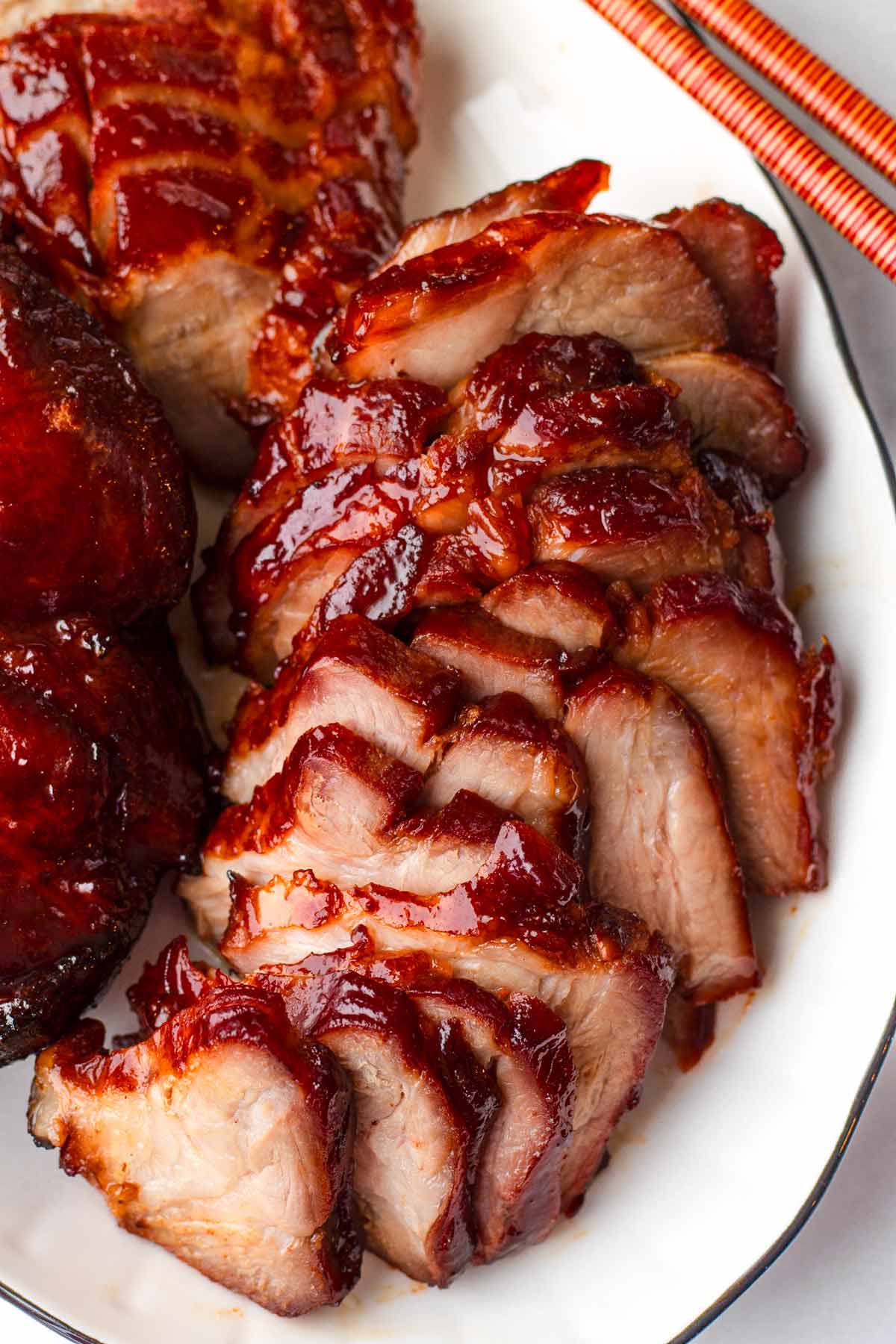
If you ask me what my favorite Chinese dish was growing up, I’d say it’s char siu, a Cantonese style barbecued pork. It’s right up there with my dad’s Beef Chow Fun!
Char siu pork an iconic dish deeply rooted in Cantonese culture. It’s comfort food. If you’ve ever traveled to Hong Kong or the Cantonese region of China, or explored Chinatowns around the world, you’ve likely seen lines of street shops selling roasted and cured meats, including this Chinese BBQ pork.
You may know char siu for its signature red color, which comes from the marinade and glaze. The marinade brings a perfect balance sweet and savory umami flavors, while the honey glaze creates the perfect caramelization.
Today, I’m sharing my dad’s authentic recipe! Over the years as a professional chef, he’s perfected his restaurant-style recipe, which I’ve adapted for home cooking. With an easy marinade and your regular oven, you can recreate this amazing dish at home.
If you like this recipe, try my Chinese BBQ Ribs too! I use the same marinade but with ribs. So good!
Why I love making this char siu (aka Chinese BBQ pork) at home:
- Authentic flavors: This recipe uses traditional ingredients, such fermented red bean curd for authentic flavors. If you can’t find these, worry not! I included substitutions below.
- Easy and straightforward: Requires minimal prep work. Just marinate the pork overnight and oven roast the next day.
- Many ways to serve: While I enjoy it with steamed rice and veggies, it’s also great with noodles, stir fries, and more!
- Make-ahead and freezer friendly: It stores and freezes really well, so I always make a big batch.
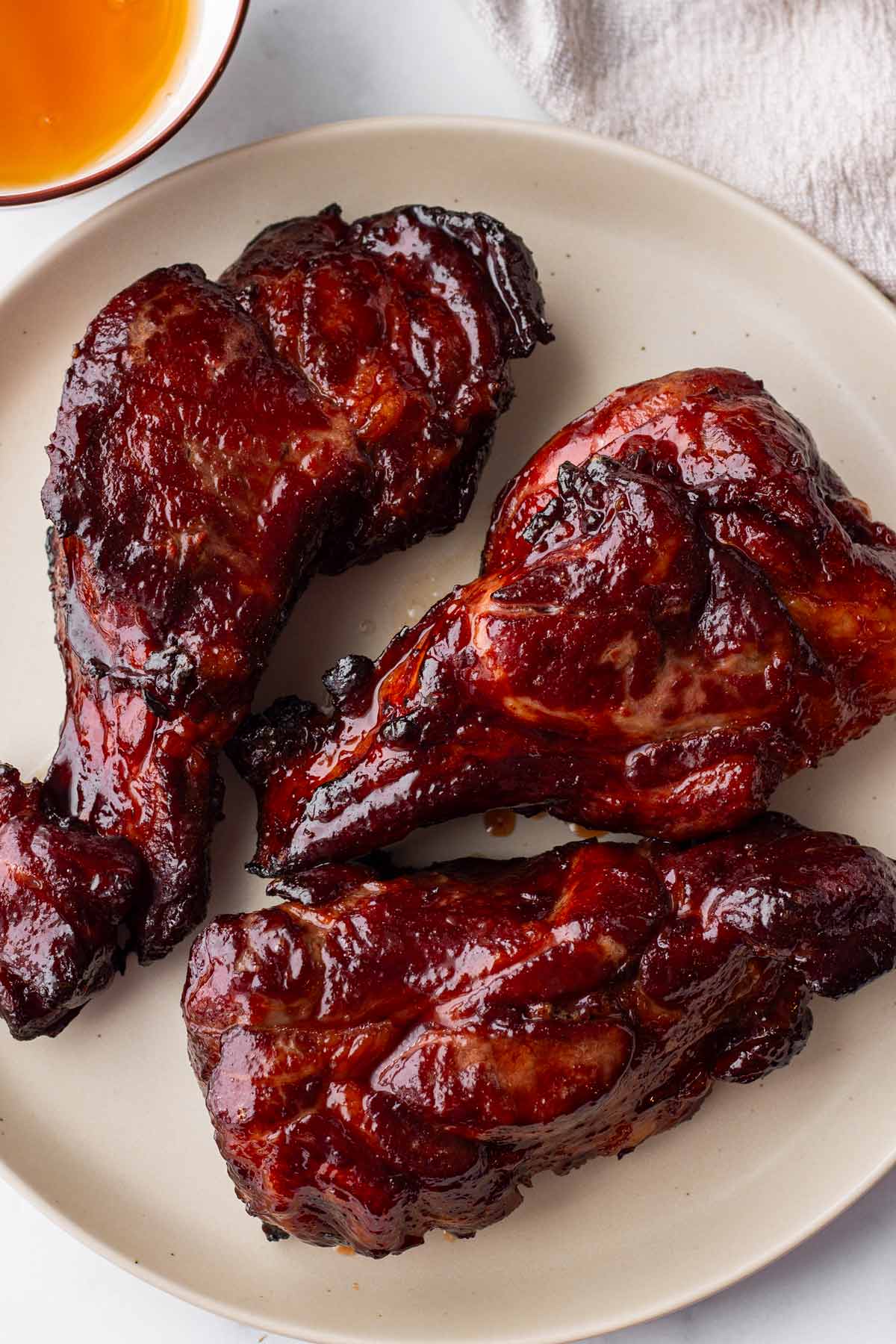
Jump to:
Ingredient Notes
This recipe uses a few traditional Chinese ingredients, which can be found in Asian grocery stores. I’ve also listed a few helpful substitutions in case you’re unable to find them.
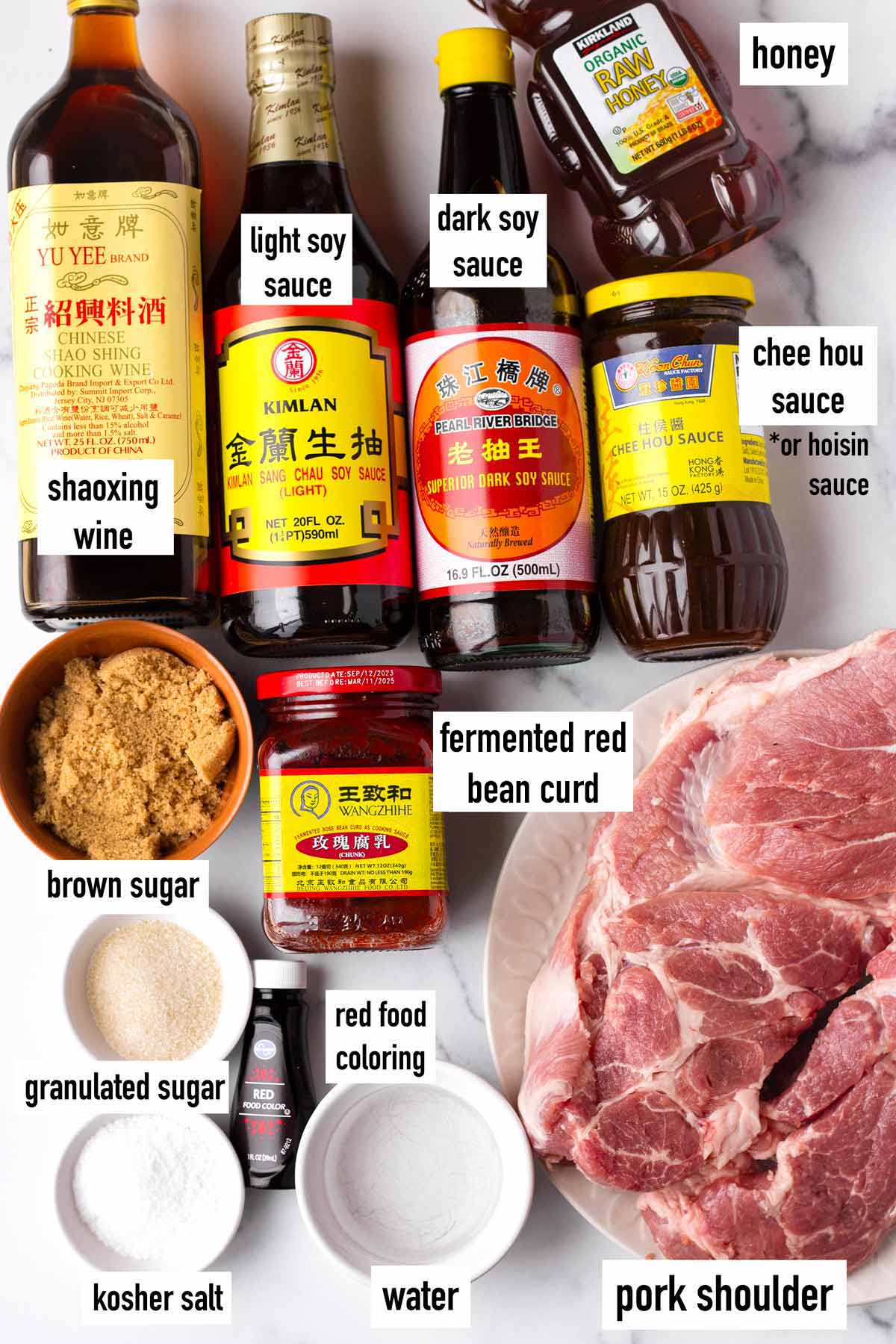
- Boneless pork shoulder: Pork shoulder has the right balance of fat and meat, ensuring it’s juicy and tender. Cut the pork shoulder into 2-3 inch thick strips. Do NOT use pork tenderloin or pork loin, as these cuts don’t have enough fat and will dry out.
- Light brown sugar: Adds sweetness and helps caramelize the pork during roasting.
- Kosher salt: For saltiness.
- Light soy sauce: Provides color and savory umami flavors.
- Dark soy sauce: Mainly for a richer color and additional depth of flavor.
- Chee hou sauce: This sauce is made mainly with soybean, garlic, ginger, and spices. If unavailable, use hoisin sauce instead. I like Koon Chun brand, but Lee Kum Kee brand also has its version called “chu hao paste.”
- Chinese Shaoxing wine: Adds flavor depth and subtle sweetness. If you can’t find it, substitute with dry sherry.
- Fermented red bean curd: This is a very traditional Chinese ingredient, so it may be harder to find. It’s red preserved tofu cubes. Its main purpose is to give the meat color and flavor. If you can’t find it, substitute with 2 tablespoons of hoisin sauce plus 1 more small droplet of red food coloring.
- Red food coloring: Used to achieve a more vibrant red color. You only need a very small amount. It doesn’t affect taste, so it’s fine to omit but the pork will be more of a brown color.
- Five spice powder: I don’t use it because I personally hate anise, which is a spice in five spice powder. But it’s commonly used in this marinade, so feel free to add.
- Honey: For the glaze, gives it that beautiful shiny and sticky exterior.
- Granulated sugar and water, also for the glaze.
Step-by-Step Tutorial
Making this recipe is actually quite simple! Marinate, roast, and glaze. So easy.
Step 1 | Cut the pork shoulder
Leave the extra fat on, unless there is an excessive amount. The fat is what makes char siu really good and juicy! Cut the pork shoulder into long strips, about 2-3 inches thick. For 3 pounds of pork shoulder, you should have about 3 long strips.
This allows the marinade to penetrate, and also for even cooking. If cut too thick, it may take too long to roast (we use high roasting temperature), which can dry out the exterior.

Step 2 | Marinate overnight
In a bowl, combine all the marinade ingredients and mix until well-combined, breaking up the red bean curd cube. Place the pork in a large resealable bag, and pour in the marinade, ensuring everything is fully coated. Seal the bag tightly, removing any excess air.
Refrigerate for at least 8 hours or preferably overnight. 12-16 hours is ideal.
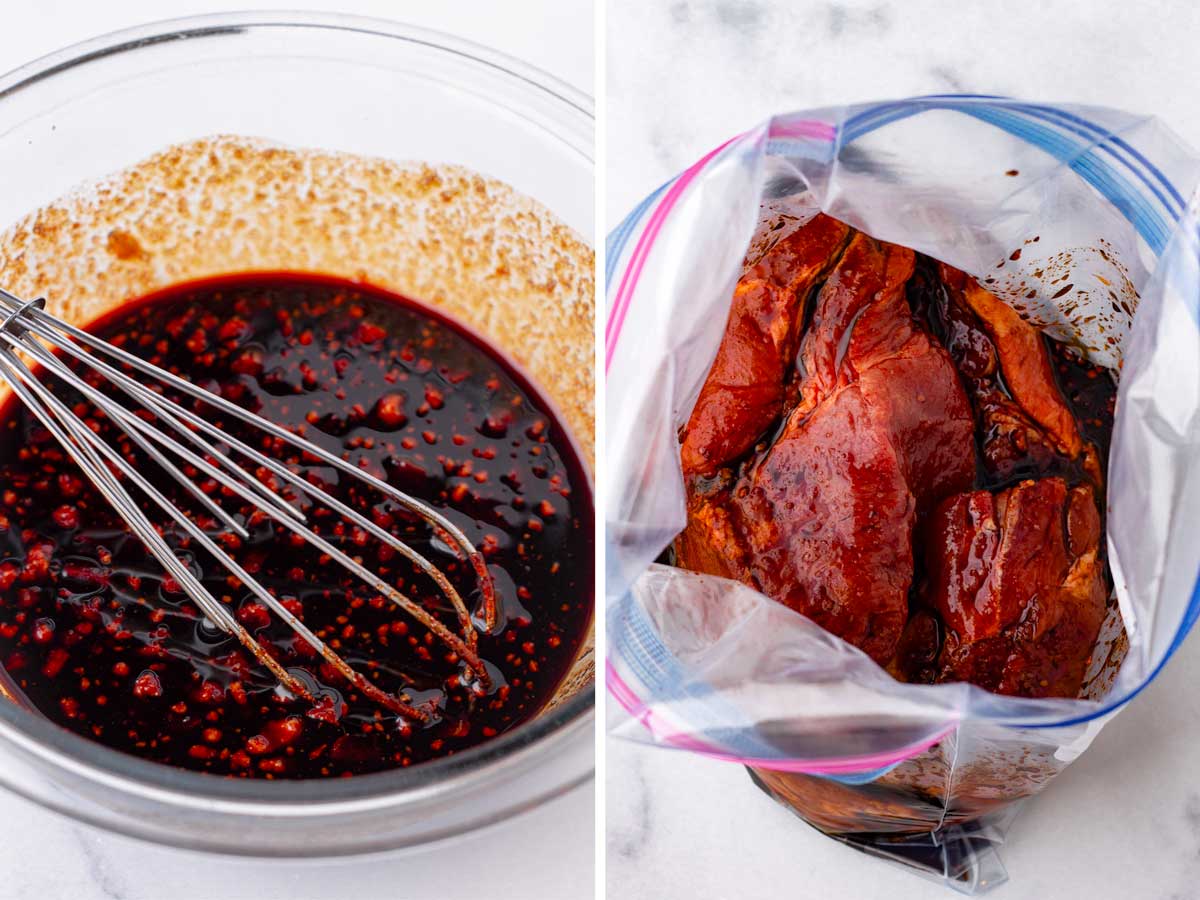
Step 3 | Roast
Preheat your oven to 425 degrees F. Line a baking sheet with foil and then place an oven-safe metal wire rack on top. We’ll need to add water under the rack to create some steam to keep everything moist.
Arrange the marinated pork on top of the rack, and save the marinade – we’ll use it for basting. Roast for 35 to 40 minutes, flipping halfway through, or until it registers 150 degrees F in the center.
Meanwhile, transfer the marinade to a small saucepan and bring to a rolling boil for just 2 minutes until slightly thickened. Use it to baste the pork every 15 minutes as it roasts.
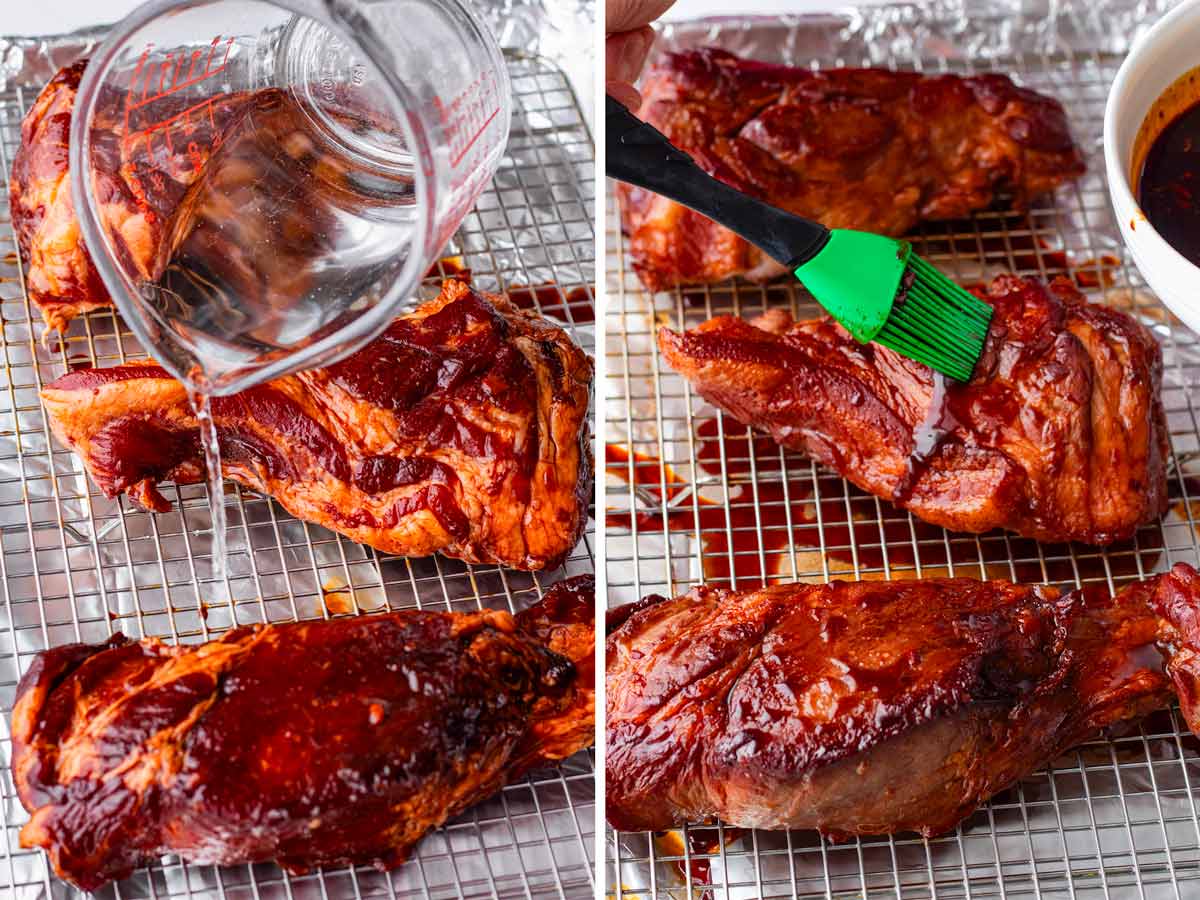
Step 4 | Brush with honey glaze
Meanwhile, make the glaze by combining honey, granulated sugar, and water. Microwave for a few seconds until a thin glaze forms, and then mix in a very small droplet of red food coloring. It should be a light red color.
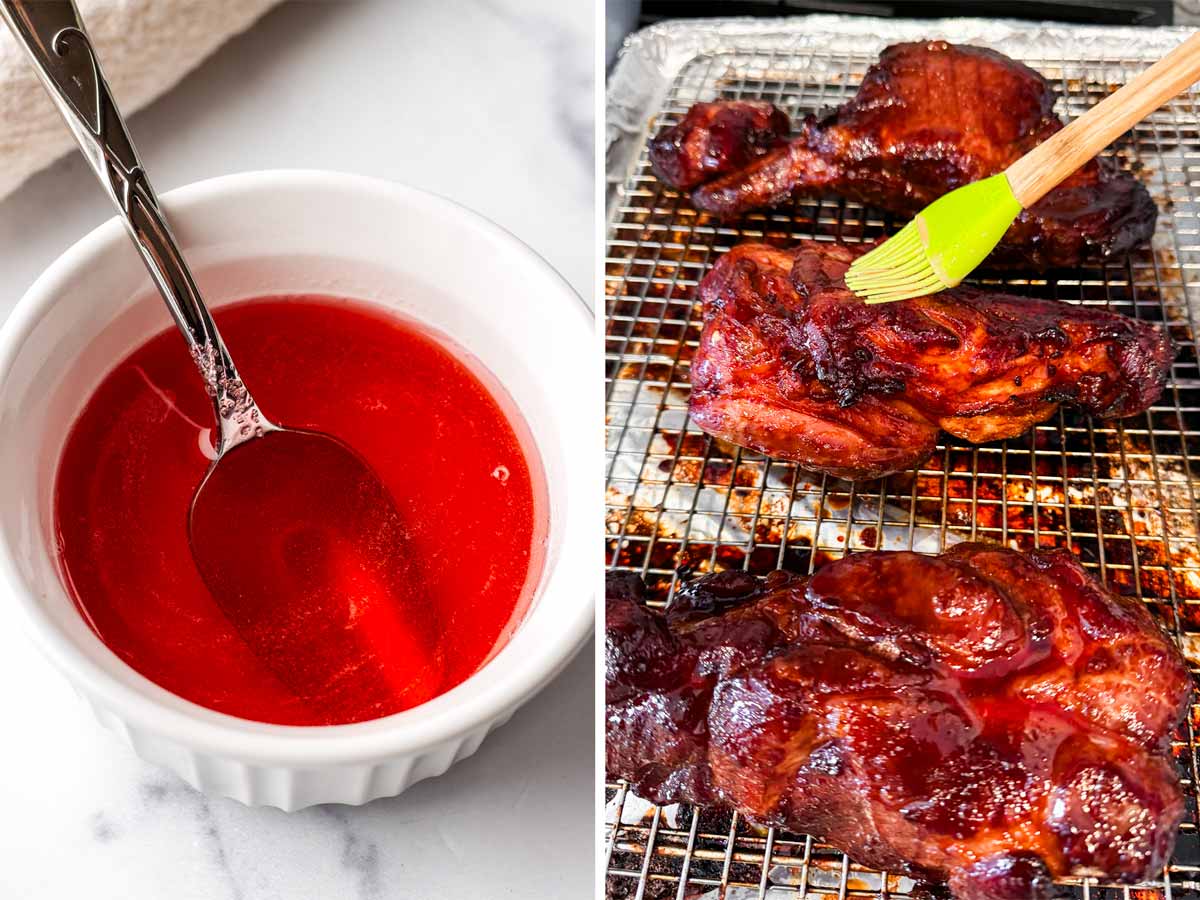
Once the pork has reached 150 degrees F, brush with the honey glaze and return to the oven. Repeat every 5 minutes for another 10-15 minutes, or until the center has reached 160 F and the exterior is caramelized and slightly charred.
Let it rest for 10 minutes before slicing against the grain. And there you have it, the BEST char siu pork ever!
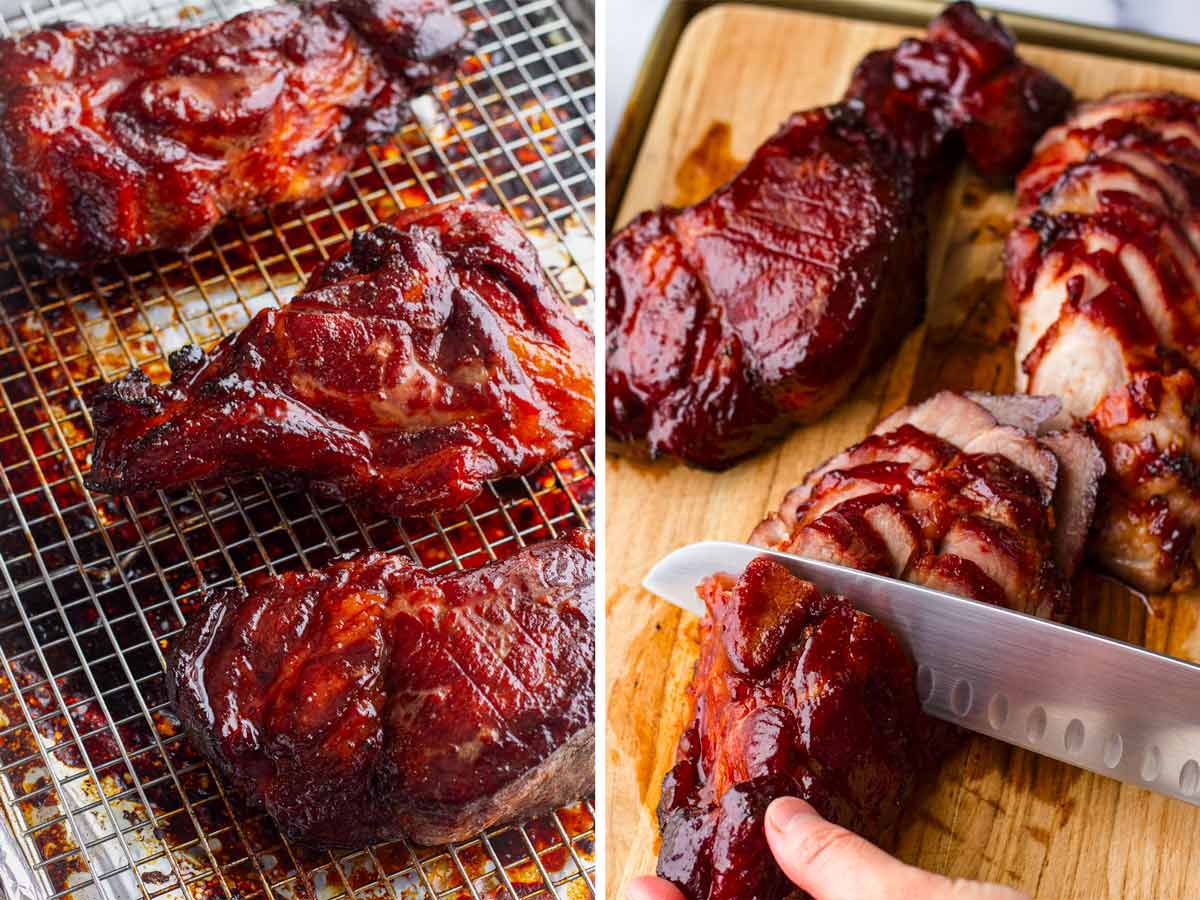
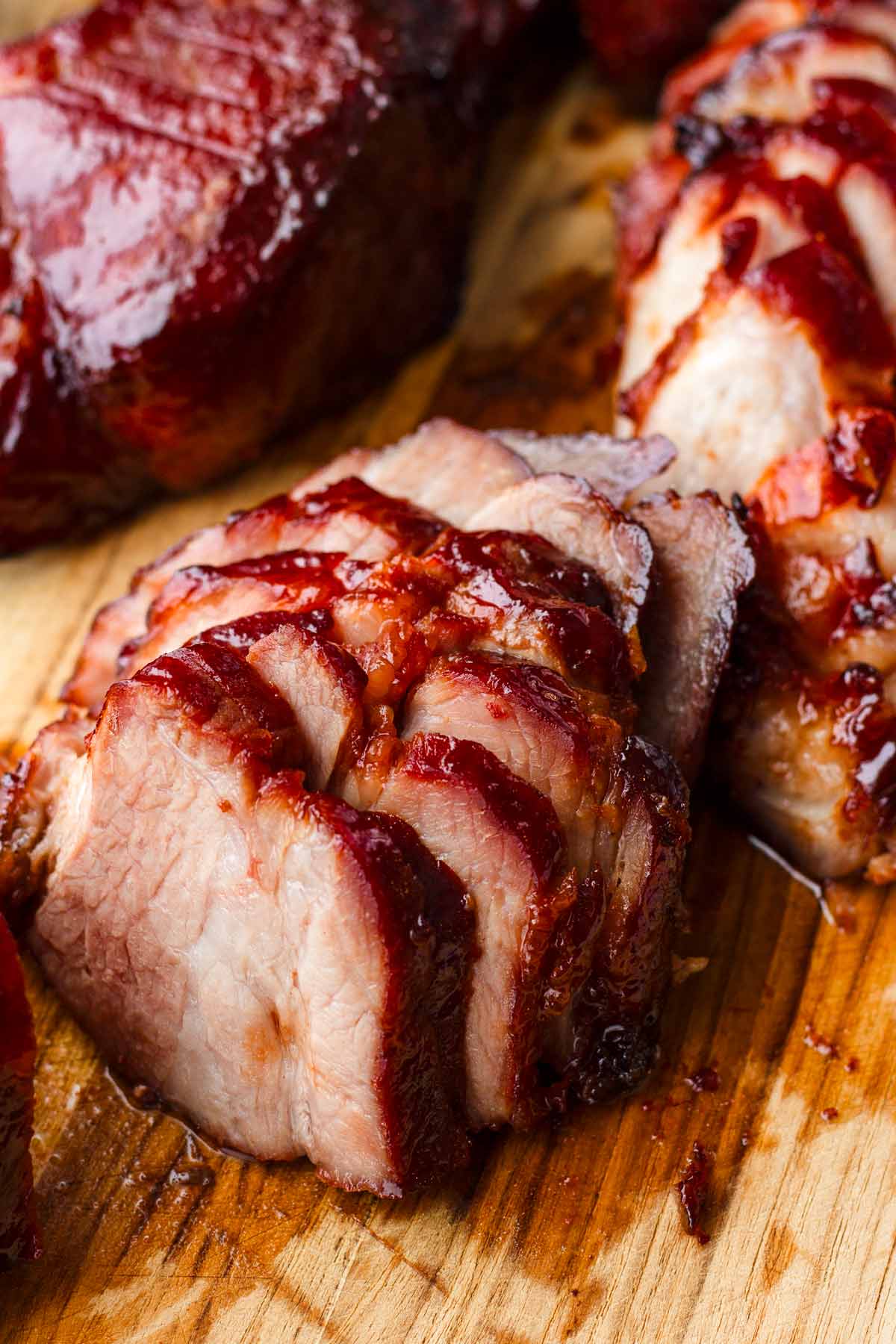
How to Serve Char Siu
This Chinese BBQ pork can be used and served in many ways. Personally, I love serving it over jasmine rice and steamed bok choy or Chinese broccoli (gai lan), or with a bowl of wonton noodle soup.
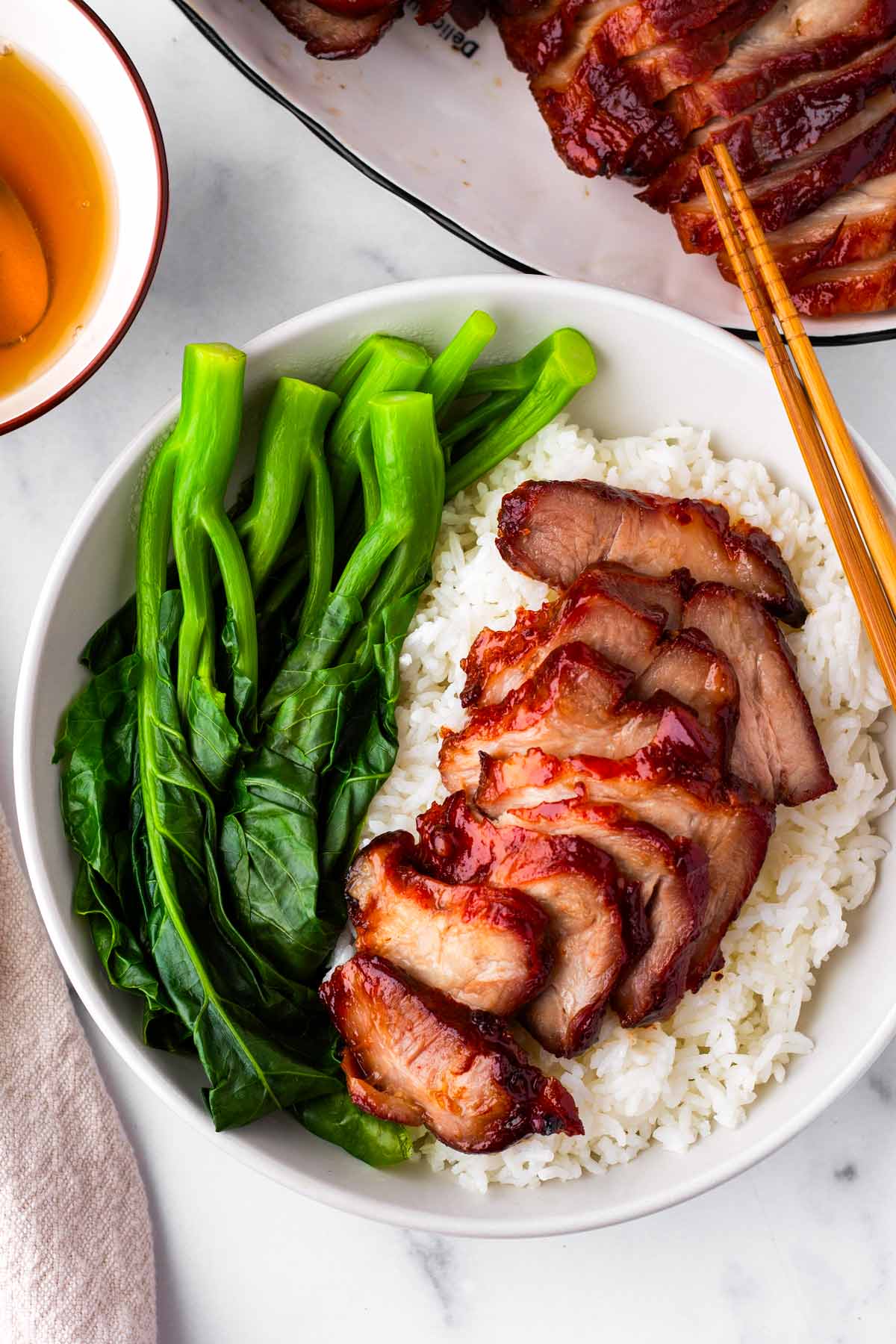
Here are some of my favorite ways to serve it:
- Serve as is! Family style, with steamed rice and any other main dishes.
- Noodle soups: Add a few char siu slices to your wonton noodle soup! It’s a popular combination.
- Noodle stir fries: Use my Shrimp Lo Mein recipe and swap out the shrimp.
- Fried rice: Add it to Golden Fried Rice or use my Chinese Sausage Fried Rice recipe.
- Stir fries: Mix and match your favorite veggies and use my Chinese Stir-Fry Sauce.
- Bao buns: Use as a filling the steamed bao buns. You can find frozen, ready-to-steam buns in most Asian grocery stores.
Looking for more authentic Asian recipes? Try my Sweet and Sour Pork and Chinese Corn Chicken Soup.
Make Ahead and Freezing
Marinate ahead: Prepare the pork and marinade overnight and refrigerate until ready to roast the next day.
If roasting ahead, do so 1 day ahead. Store in the fridge in an airtight container. Reheat in the microwave oven the next day. Store leftovers for up to 3-5 days in an airtight container in the fridge.
Freezing: Let cool completely. Freeze in freezer-friendly bags for up to 3 months. Thaw in the fridge overnight and reheat.
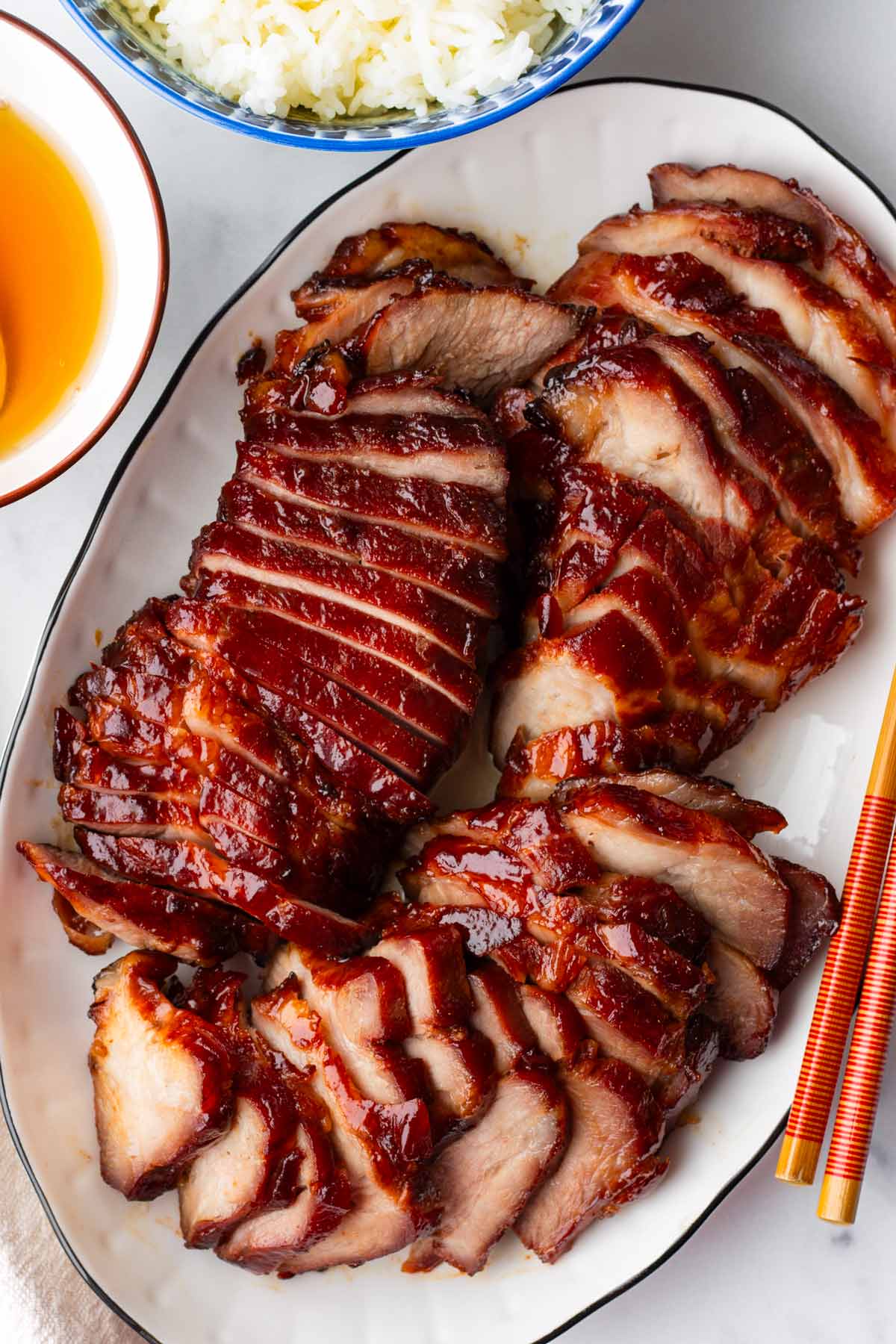
Recipe FAQs
You need a fatty cut of pork. Boneless pork shoulder is ideal. Don’t use pork loin or tenderloin because it will turn out dry.
This is a very traditional Chinese ingredient used mainly for flavor and marinades, and can sometimes be hard to find. It’s used for that red color and depth of umami flavor. If you can’t find it, substitute with 2 tablespoons of hoisin sauce and a small drop of red food coloring.
It’s optional, but I like to use a little bit for a more vibrant color in addition to the red bean curd liquid. It doesn’t affect the final taste, just the color.
It should be cooked to 160 degrees F. Traditionally, char siu pork is never served medium rare nor medium.
Tips for Success
- Use boneless pork shoulder, which is fatty enough to keep it juicy and moist. The fat will render as it roasts at high temperature. Do not use pork loin or tenderloin – it will turn out dry.
- Roast until the center reaches 160 degrees F. Char siu is never served medium or medium rare.
- Use an oven-safe wire rack for roasting. This ensures even cooking and prevents the pork from sitting in its juices. Plus, we need to add a layer of water to the bottom of the pan, so the rack keeps the meat elevated for air circulation.
- Apply the glaze generously towards the end. Once the pork reaches 150 F, start brushing with the glaze every 5 minutes until it reaches 160 F.
I’d love to hear from you! If you loved my recipe, please consider leaving a 5-star rating and a comment down below. Sign up for my newsletter and follow along on Instagram, Facebook, or Pinterest
Char Siu (Chinese BBQ Pork)
Equipment
- Metal wire rack oven-safe
- Resealable bags 1 gallon
Ingredients
- 3 pounds boneless pork shoulder - cut into 2-3 inch thick long strips
Marinade:
- 6 tablespoons light brown sugar
- 3 ½ teaspoons Kosher salt - or 2-½ teaspoons table salt
- 1 tablespoon light soy sauce
- 1 tablespoon dark soy sauce
- 1 tablespoon chee hou sauce - can substitute with hoisin sauce
- 1 ½ tablespoons Chinese Shaoxing cooking wine
- 2 tablespoons fermented red bean curd - use 1 cube plus 1 tablespoon liquid
- ¼ teaspoon five spice powder - optional, see note
- ⅛ teaspoon red food coloring - see note
Honey glaze:
- ⅓ cup honey
- 2 ½ tablespoons granulated sugar
- 3 tablespoons water
- A very small drop of red food coloring - or ½ teaspoon of the red bean curd liquid
Instructions
- Cut the pork shoulder into long strips of 2-3 inches thick. Transfer to a large resealable bag. There is no need to trim the extra fat, unless there is an excessive amount. The fat will keep the pork extra moist and render while roasting.
- In a bowl, mix all the marinade ingredients until evenly combined, breaking up the red bean curd cube. Add the marinade to the pork, ensuring everything is fully coated. Seal the bag, removing excess air, and marinate in the fridge for at least 8 hours or preferably overnight. 12-16 hours is ideal.
- Preheat oven to 425 degrees F.
- Prep the roasting pan: Line a large sheet pan with foil, and place an oven-safe metal wire rack on top. Add a layer of water at the bottom, this will create steam for moisture.
- Arrange the marinated pork on top (save the marinate for later). Roast in the preheated oven for 40-45 minutes, flipping halfway through, until it reaches 150F. Note: You'll need to baste it periodically, see next step.
- Meanwhile, in a small saucepan, bring the leftover marinade to a quick low boil for just 2 minutes until slightly thickened. Use it to baste the pork every 15 minutes. If needed, replenish the water at the bottom of the roasting pan.
- Honey glaze: In a bowl, combine the honey, granulated sugar, and water. Microwave for a few seconds until you get a thin glaze. Then, add a very small droplet of red food coloring (or ½ tsp of the red bean curd liquid) and mix. Tip: If it starts to thicken, pop it in the microwave oven for a few seconds.
- Once the pork registers 150 degrees F in the center, brush with prepared honey glaze and return to the oven. Repeat every 5 minutes until caramelized and somewhat charred around the edges. It’s ready when the center reaches 160 degrees F in the center. Total cook time should be about 50-55 minutes, depending on the thickness.
- Remove from the oven and let it rest for 10 minutes. Slice against the grain. Enjoy!
Notes
- How to get that red color: The fermented red bean curds (plus the liquid) contribute to the color. I also add a little bit of red food coloring for a more vibrant color, but feel free to omit it if preferred. It only affects color, taste is unaffected.
- Five spice powder: I don’t use it because I hate anise (personal preference), which is a spice in five spice powder. However, it’s commonly used, so feel free to add to taste.
- Internal temperature of the pork should be 160 degrees F. Char siu is never served medium or medium rare.
- Best cut of meat: Use boneless pork shoulder for its fat content. Avoid pork loin or tenderloin, as they tend to dry out.
- Roasting setup: Use an oven-safe wire rack on top of a sheet pan. If you don’t have a rack, crumpled aluminum foil can serve as a quick alternative.
- Freezing: Slice and let cool completely. Freeze for up to 3 months. Thaw overnight in the fridge or reheat in the oven from frozen.
- Air fryer: Bring the marinated pork to room temp. Air fry at 385 F for a total of 20-25 minutes, flipping halfway through and basting. 10 minutes before the time is up, brush with the glaze.
- Fermented red bean curd: 2 tablespoons of hoisin plus a small drop of red food coloring. Note that there is a regular version and a “rose” version, both are fine to use.
- Chee hou sauce (aka chu hao paste): Hoisin sauce.
- Chinese Shaoxing wine: Dry sherry.
- Meat: Use pork shoulder. Don’t use pork loin or tenderloin (too dry).


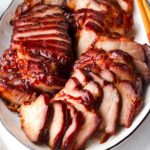
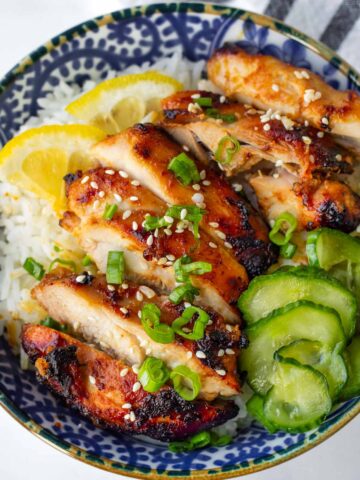

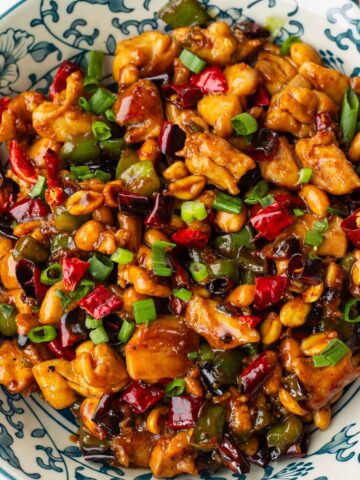
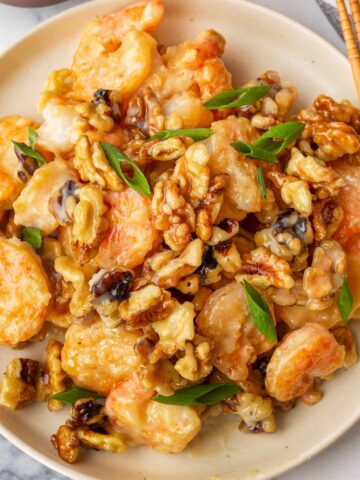


Maru Bustamante says
I recently tried this char siu recipe, and it was absolutely phenomenal! The marinade was a perfect blend of sweet and savory, with just the right amount of five-spice powder to elevate the flavors. The pork turned out incredibly tender and juicy, caramelizing beautifully in the oven.
I followed the instructions carefully, and I can confidently say that this dish rivals my favorite Chinese restaurant! Even the leftovers were delicious the next day!
Thank you for sharing!!! Nos encanto
Tania says
Thank you so much Maru! So happy you loved our char siu recipe!
Patricia says
Loved it. Stays moist and juicy. Also love the sticky and charred edges. I cooked them a little longer than the recipe noted because my pork was on the thicker side. Will make again.
Tania says
Thank you, Patricia! Glad you enjoyed it.